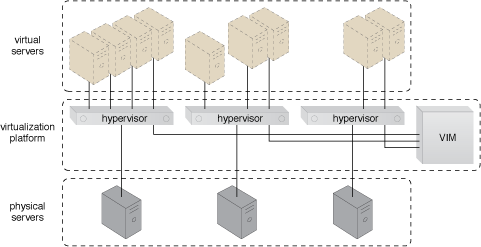Cloud Computing Patterns, Mechanisms > Mechanisms > D - H > Hypervisor
Hypervisor

The hypervisor mechanism is a fundamental part of virtualization infrastructure that is primarily used to generate virtual server instances of a physical server. A hypervisor is generally limited to one physical server and can therefore only create virtual images of that server (Figure 1). Similarly, a hypervisor can only assign the virtual servers it generates to resource pools that reside on the same underlying physical server. A hypervisor has limited virtual server management features, such as increasing the virtual server’s capacity or shutting it down. The VIM provides a range of features for administering multiple hypervisors across physical servers.

Figure 1 – Virtual servers are created via individual hypervisors on individual physical servers. All three hypervisors are jointly controlled by the same VIM.
Hypervisor software can be installed directly in bare-metal servers and provides features for controlling, sharing and scheduling the usage of hardware resources, such as processor power, memory, and I/O. These can appear to each virtual server’s operating system as dedicated resources.
Related Patterns:
- Automated Administration
- Bare-Metal Provisioning
- Cross-Hypervisor Workload Mobility
- Detecting and Mitigating User-Installed VMs
- Direct I/O Access
- Direct LUN Access
- Dynamic Scalability
- Elastic Disk Provisioning
- Elastic Network Capacity
- Elastic Resource Capacity
- External Virtual Server Accessibility
- Hypervisor Clustering
- Leader Node Election
- Load Balanced Virtual Server Instances
- Load Balanced Virtual Switches
- Memory Over-Committing
- Multipath Resource Access
- NIC Teaming
- Non-Disruptive Service Relocation
- Persistent Virtual Network Configuration
- Platform Provisioning
- Power Consumption Reduction
- Rapid Provisioning
- Redundant Physical Connection for Virtual Servers
- Resource Pooling
- Resource Reservation
- Service State Management
- Shared Resources
- Single Node Multi-Containers
- Single Root I/O Virtualization
- Synchronized Operating State
- Virtual Disk Splitting
- Virtual Server Auto Crash Recovery
- Virtual Server Connectivity Isolation
- Virtual Server Folder Migration
- Virtual Server NAT Connectivity
- Virtual Server-to-Host Affinity
- Virtual Server-to-Host Anti-Affinity
- Virtual Server-to-Host Connectivity
- Virtual Server-to-Virtual Server Affinity
- Virtual Server-to-Virtual Server Anti-Affinity
- Virtual Switch Isolation
- Workload Distribution
- Zero Downtime
This mechanism is covered in CCP Module 4: Fundamental Cloud Architecture.
For more information regarding the Cloud Certified Professional (CCP) curriculum, visit www.arcitura.com/ccp.
This cloud computing mechanism is covered in:
Cloud Computing: Concepts, Technology & Architecture by Thomas Erl, Zaigham Mahmood,
Ricardo Puttini
(ISBN: 9780133387520, Hardcover, 260+ Illustrations, 528 pages)
For more information about this book, visit www.arcitura.com/books.

